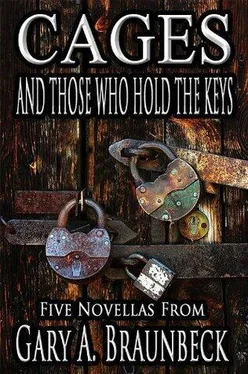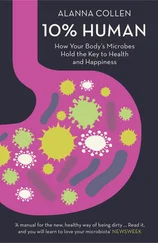“And alliteration,” I said. “That’s the second time since we’ve met that you’ve done that.”
“Is it, now? I shall have to take care to watch my tongue.”
The cage slowed, then shuddered once again as it moved onto another platform, disengaging from the overhead track as the front-most door rose up automatically and another set of iron doors opened before us.
We entered another brightly-lighted hallway, this one with a highly-polished off-white floor and walls the same color. The iron doors closed behind us and the stink of the factory was replaced by the sharp, antiseptic smells of a hospital. I moved alongside Daddy Bliss. “And this is…?” “The Pre-Repair Unit.” All of the doors were closed, and there were no personnel working the floor. We paused by one of the closed doors. Daddy Bliss jerked his head to the side, gesturing. “Why don’t you take a look through the observation window there?” I did. I wish to hell I hadn’t.
All I can for certain is that the person lying in there was female; she could have been 17, she could have been 52—it was impossible to tell. Her massive facial injuries rendered her features almost unrecognizable as being human. Her lower body was covered by a sheet. From the ceiling there extended down a pencil-thick cable that spread out at the bottom like the wires inside an umbrella, each one attached to one of the spark plugs implanted in her skull. She jerked underneath the sheet as if in the midst of a seizure, arms and legs twitching as the sparkplugs lit up in a precisely-timed sequence. Her eyes were held closed by two heavy strips of medical tape. A clear plastic tube ran from her throat into a large glass jar set on a metal table beside the bed; with each jerk, dark viscous liquid crawled through the tube and oozed into the jar. With each sequence of sparks she bit down hard on her lower lip, breaking the skin and dribbling blood down the side of her face. Finally, one of the convulsions was so violent that she ripped the sheets from over her body, exposing the metal rings that encased her torso from the center of her chest down to her knees. It looked as if she were being tortured.
I looked away, took several deep breaths to stop myself from vomiting, then looked down at Daddy Bliss and said, “Where are the nurses and doctors?”
“There aren’t any. All of the medical care here is automated. The girl you saw in there is recovering from an emergency procedure. Her body rejected its new torso, so a new one is being made for her. Hopefully, we’ll have better luck this time.”
I looked through the window again, this time seeing that what I’d mistaken for metal rings were actually grooves in a massive cylindrical chamber encircling the center section of the bed.
“It’s holding her organs in place,” said Daddy Bliss as if I’d asked the question out loud. “Some of her bone structure remained intact, but not nearly enough.”
“How long can you keep her alive in that condition?”
“Indefinitely. She’s a stubborn case, that one. She’s insisting on the full Repair, no matter how long it takes. When her Repairs are complete, we shall name her Pinto, and love her as a family should love a new member.”
Next to the door was a small framed black and white photograph of a young woman that would have looked right at home in the center of a roadside memorial wreath. “Is this her?” I asked, pointing at the photograph. “That is how her family chose for the world to remember her, yes.” “Was this taken from a memorial?” “Of course. That’s always the second step in the Repair process.” I stared at him for a moment. “What’s the first step?” “I’d think that would be obvious—taking the soul from the shell before the body dies completely.” I looked back in at Pinto. She shuddered once more, and so did I.
“I don’t…I don’t understand how this is possible,” I said. “How do you get their bodies? Rob the graves after they’re buried? What if they’re cremated?”
Daddy Bliss rolled toward me. “The bodies left at the accident scenes are of no use to us—besides, the survivors have to have something grieve over and bury, don’t they? We’re not quite that heartless. No, the soul is the key. The soul, as it turns out, is a curious thing. In the initial stages of Repair, the soul’s identity is still tied very closely to the individual’s self-image—how they think of themselves, physically.
“At some point in everyone’s life, they lock onto an image of themselves—how they looked at 27, or 32, or 45—as being, for lack of a better way to put it, the best they will ever appear, and it is this image that ties itself to the soul’s memory. Depending on how quickly the soul is retrieved, much of that physical identity remains easily accessible, so it’s not difficult to convince the soul to bring forth that physical identity once again.” He smiled. “You’d be surprised how easy it is for a just-taken soul to summon flesh from the ether.
“The difficulty lies in how long it takes to have the soul delivered to us. In most cases, the Highway People deliver them here in a few seconds, but sometimes, when the Road has been particularly demanding on certain nights, it may take as long as two minutes before they are brought to us. When that happens, the soul has already begun its process of ‘letting go’ of the physical identity, and so what flesh is summoned from the ether is, well… incomplete . When that happens, we are forced to improvise with whatever materials are on hand.”
I pointed toward the picture hanging outside Pinto’s room. “Why the photos?”
“Consider them a way of checking the quality of our workmanship. Luckily, those friends and family left behind inevitably choose a memorial photograph that was taken of their loved during this ‘ideal’ image time. When the soul has forgotten too much of the physical identity, we take the photograph and use it as our blueprint.”
“But how can you be sure that…that you’re Repairing them correctly?”
“Not to oversimplify, dear boy, but Road Mama and I decided long ago to use only three basic body types as our Repair base: endomorph—the larger and fleshier body; mesomorph—the more muscular type, and ectomorph—the slender or lean body type. These three types rarely show up in pure forms, but rather in numerous but finite combinations. Once we have what flesh the soul remembers, and the photograph, it’s not difficult to discern which body type—or combination of body types—is required for the Repair process. Would you mind showing me your watch?”
The sudden change of subject caught me off-guard, but I did as he asked.
“Ah, how time does slip away,” he said, looking at the hour. “Not that I’m not thoroughly enjoying our talk, Driver, but we’re on a bit of tight schedule this evening. Come along.”
He moved on down the hall.
I almost looked in at Pinto again, then knew I couldn’t; another glance at her condition, and I might start laughing, and if I started laughing, I knew I’d never stop.
So I followed him.
I did not look through any more observation windows or at any of the memorial photographs hanging beside the doors.
We turned right at the end of the hall and moved toward a door with frosted glass window with the words Control Center #1stenciled onto the glass. A security camera mounted over the door tracked our every move.
When he reached the door, Daddy Bliss once again looked up and smiled at the camera; once again, the door automatically unlocked and swung open.
We entered a medium-sized room that was taken up by expensive computer equipment. There must have been a dozen high-end machines working away in there, all of them with 25- and 40-inch LCD monitors, and all arranged on a series of wall-mounted shelves so that the sole person working the room could roll her office chair from unit to unit without banging her legs against anything. And it appeared that Ciera—the strawberry blonde girl who’d been collecting the roadside memorials—was very busy, indeed. Daddy Bliss gave her a quiet, loving look. “How are things going, my dear?” “Just fine, Daddy. You’re just in time for Lexington.”
Читать дальше












